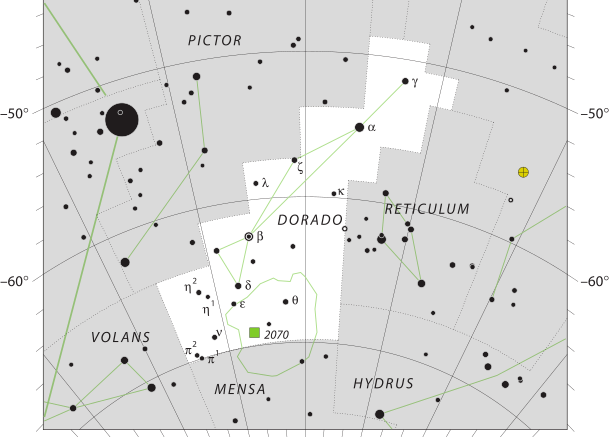Located on the South Ecliptic pole in the Southern Hemisphere, the constellation Dorado is often depicted as a swordfish or a dolphinfish. Created in the late 16th century, Dorado is not visible in the Pacific Northwest. The most prominent stars in Dorado is the majority of the Large Magellanic Cloud, with the remainder being located in the constellation Mensa, and the Tarantula Nebula, which is one of the most prolific star forming areas in the entire galactic neighborhood.
The Latin name for Dorado is Doradus, as the name Dorado is actually Portuguese.
| Applicable Information | |
| Visibility In Pacific Northwest | Not visible in Pacific Northwest |
| Best Times To View | Not visible in Pacific Northwest |
| Right Ascension | 5h |
| Declination | −65° |
| Area | 179 square degrees |
| Main Stars | 3 |
| Brightest Object | α Dor |
| Meteor showers | 0 |
| Messier objects | 0 |
| Neighboring Constellations | Caelum, Horologium, Reticulum, Hydrus, Mensa, Volans, Pictor |
History
Using the observations of Pieter Dirkszoon Keyser and Frederick de Houtman, Petrus Plancius create 12 constellations, which included Dorado. The first appearance of the constellation was on a 35-centimeter-diameter celestial globe published in 1597 in Amsterdam, with the first celestial atlas to depict Dorado was in Johann Bayer’s Uranometria of 1603.
Although the constellation was known by some in the 17th and 18th century as Xiphias, the name Dorado ultimately become the chosen name we use today for the constellation.
Stars
The most notable feature in Dorado is that it contains part of the Large Magellanic Cloud, which makes the constellation rich in deep sky objects. It is estimated that the Large Magellanic Cloud is a 25,000-light-year-wide galaxy containing over 10,000 million stars. This makes Dorado a very rich constellation for deep sky objects.
Open Clusters
- NGC 1869, NGC 1901, NGC 1910, NGC 1820, NGC 1978, NGC 2002, and NGC 2027
Globular Clusters
- NGC 1755, NGC 1850, NGC 1854, and NGC 2164
Emission Nebula
- NGC 2074, N 180B, and NGC 2080 which is called the “Ghost Head Nebula.”
Others
- NGC 1566 is a face-on spiral galaxy, which gives its name to the NGC 1566 Group of galaxies.
- NGC 1763 is a bright nebula associated with 3 type B stars.
- NGC 1936 is a bright nebula and is one of four NGC objects in close proximity. The 3 NGC objects in close proximity are NGC 1929, NGC 1934 and NGC 1935.
- NGC 2032, otherwise known as the “Seagull Nebula”, is a nebula complex that contains 4 NGC designations: NGC 2029, NGC 2032, NGC 2035 and NGC 2040.
- LEDA 89996 is a beautiful and classic spiral galaxy.
- Tarantula Nebula is in the Large Magellanic Cloud, named for its spiderlike shape. The Nebula is also designated 30 Doradus, as it is visible to the naked eye as a slightly out-of-focus star.
- N44 is a superbubble in the Large Magellanic Cloud that is 1,000 light-years wide.
Make sure to check out other articles on the site, including a brief introduction to constellations, other constellation articles, and more!

Be the first to comment on "Dorado"